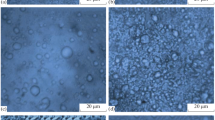Abstract
Lecithin in cosmetic emulsions produces a unique “skin feel,” which can be related to its rheological properties. In this study, water-in-oil (w/o) and oil-in-water (o/w) emulsions were made from a cosmetic-grade caprylic/capric triglyceride with deoiled lecithin and hydroxylated lecithin. Synthetic surfactants commonly used in commercial cosmetic products were used as controls. Optical light microscope investigation showed significant differences in the structures of the w/o and o/w emulsions made with the lecithins. Freeze/thaw tests were conducted to evaluate emulsion stability. The o/w emulsion (oil/water = 20:80) was stable with 3% hydroxylated lecithin at room temperature. However, 4% hydroxylated lecithin was needed for stabilizing the emulsion with an oil-to-water ratio of 20:80 or 30:70 through the freeze/thaw treatments. With 4% deoiled lecithin, the w/o emulsion showed a water-holding capacity up to 80%, which was also stable through two freeze/thaw cycles. All emulsions in this study exhibited pseudoplastic flow, in which a minimum shearing stress, a yield value, was required before flow became linear. In general, the emulsion viscosity increased as lecithin content increased. Changing the oil-to-water ratio also affected the emulsion viscosity. The deoiled lecithin-based w/o emulsions had higher yield values than hydroxylated lecithin-based o/w emulsions. Therefore, more force was needed to spread the w/o emulsions. In addition, because w/o emulsions had more viscous continuous phases and a greater volume of internal phases, the w/o emulsions were more viscous than the o/w emulsions.
Similar content being viewed by others
References
Scholfield, C.R., Occurrence, Structure, Composition and Nomenclature, in Lecithins, edited by B.F. Szuhaj and G.R. List, The American Oil Chemists’ Society, Champaign, 1985, pp. 1–20.
Baker, C., Lecithin in Cosmetics, in Lecithin: Sources, Manufacture & Uses, edited by B.F. Szuhaj, The American Oil Chemists’ Society, Champaign, 1989, pp. 253–260.
Conry, T., Ingredient Dictionary, in Consumer’s Guide to Cosmetics, edited by T. Conry, Anchor Books, Garden City, 1980, pp. 320–337.
Larsson, K., Stability of Emulsions Formed by Polar Lipids, Prog. Chem. Fats Other Lipids 16:163–169 (1978).
Weete, J.D., S. Betageri, and G.L. Griffith, Improvement of Lecithin as an Emulsifier for Water-in-Oil Emulsions by Thermalization, J. Am. Oil Chem Soc. 71:731–737 (1994).
Johansson, D., and B. Bergenstahl, Lecithins in Oil-Continuous Emulsions—Fat Crystal Wetting and Interfacial Tension, Ibid.:205–211 (1995).
List, G.R., Commercial Manufacture of Lecithin, in Lecithins: Sources, Manufacture & Uses, edited by B.F. Szuhaj, The American Oil Chemists’ Society, Champaign, 1989, pp. 145–161.
Sinram, R.D., The Added Value of Specialty Lecithins, Oil Mill Gaz. 97(9):22–26 (1991).
Isacoff, H., Cosmetics, in Encyclopedia of Chemical Technology, 3rd edn., Vol. 7, edited by M. Grayson, John Wiley & Sons, Inc., New York, 1979, pp. 143–176.
Lissant, K.J., Basic Theory, in Emulsions and Emulsion Technology, edited by K.J. Lissant, Marcel Dekker, Inc., New York, 1974, pp. 1–69.
Rydhag, L., and I. Wilton, The Function of Phospholipids of Soybean Lecithin in Emulsion, J. Am. Oil Chem Soc. 58:830–837 (1981).
Johansson, D., and B. Bergenstahl, The Influence of Food Emulsifiers on Fat and Sugar Dispersions in Oils—II. Rheology, Colloidal Forces, Ibid.:718–727 (1992).
Fox, C., Cosmetic Emulsions, in Emulsions and Emulsion Technology, edited by K.J. Lissant, Marcel Dekker, Inc., New York, 1974, pp. 701–933.
Author information
Authors and Affiliations
Corresponding author
About this article
Cite this article
Zhang, F., Proctor, A. Rheology and stability of phospholipid-stabilized emulsions. J Amer Oil Chem Soc 74, 869–874 (1997). https://doi.org/10.1007/s11746-997-0230-x
Received:
Accepted:
Issue Date:
DOI: https://doi.org/10.1007/s11746-997-0230-x




